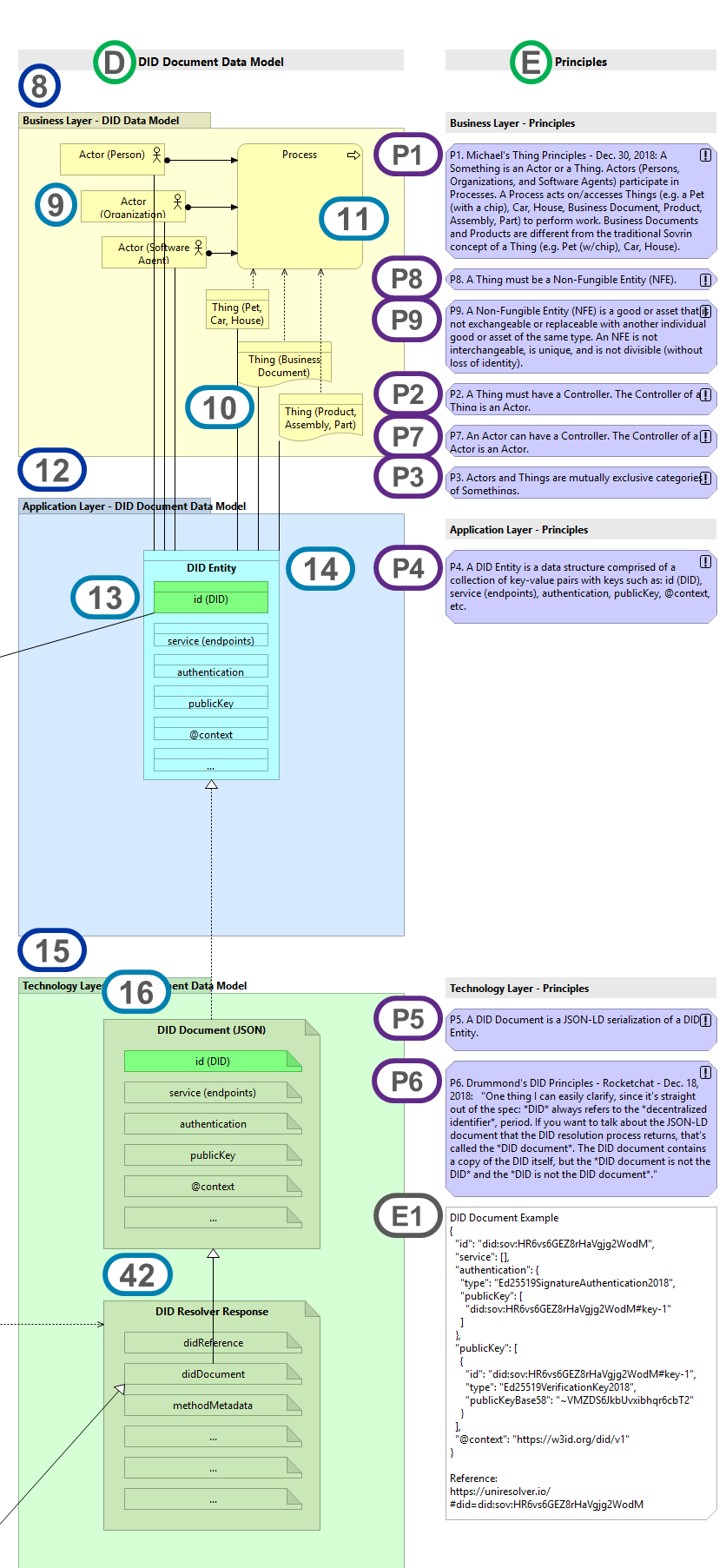-
Notifications
You must be signed in to change notification settings - Fork 12
New issue
Have a question about this project? Sign up for a free GitHub account to open an issue and contact its maintainers and the community.
By clicking “Sign up for GitHub”, you agree to our terms of service and privacy statement. We’ll occasionally send you account related emails.
Already on GitHub? Sign in to your account
[Abstract] DID Subject: There's issues with DID Subject not being well defined #16
Comments
|
Totally agreed. This is one of the issues I've been wanting to tackle in
the WORST way. In the next draft of the spec, I think we need to make the
term "DID Subject" clear as a bell: *it is the term for the entity
identified by a DID.* Full stop.
…On Thu, Feb 7, 2019 at 6:52 AM Michael Herman (Toronto) < ***@***.***> wrote:
DID Subject is not well defined in the draft DID spec: see
w3c-ccg/did-spec#115 <w3c-ccg/did-spec#115>
—
You are receiving this because you are subscribed to this thread.
Reply to this email directly, view it on GitHub
<#16>, or mute the thread
<https://github.com/notifications/unsubscribe-auth/ADLkTUDga4UhtR7uBcig_UML7F_z0Rt1ks5vLC-jgaJpZM4anVkW>
.
|
|
+1, defining this clearly in the main DID spec will also help us with clear language in DID Resolution. |
@talltree If I''m following your explanation (aka dreaming the same dream), maybe ...or is I think |
|
Mike, I'm not sure if I completely understand your question. But I can
clarify the very simple clear way I think about this based on my 20 years
of working with identifiers: *an identifier is the label on a directed edge
in a graph that always points at a single node*.
In the case of the DID spec, the identifier is called a *DID*, and what we
need to agree on is the term we will use for the completely generic concept
of *the node being identified by the DID*.
The proposal on the table is *DID Subject*. While there are a number of
other candidates that could work, such as DID Entity, I like DID Subject
because it is parallel to the same term in the Verifiable Claims Working
Group, i.e., the entity described by a verifiable claim is called the
Subject.
Thoughts?
…On Fri, Feb 8, 2019 at 7:53 AM Michael Herman (Toronto) < ***@***.***> wrote:
I think we need to make the term "DID Subject" clear as a bell: *it is
the term for the entity identified by a DID.* Full stop.
@talltree <https://github.com/talltree> If I''m following your
explanation (aka *dreaming the same dream*), maybe DID Subject (once
clarified) is the same thing I've been wanting to call a DID Entity in
the INDY ARM "DID Subjects" viewpoint (
https://github.com/mwherman2000/indy-arm/blob/master/README.md#5-did-entity-did-subject-viewpoint
)?
...or is DID Subject more of an abstract/virtual/business thing similar
to/like Actor (9) and Thing (10) in the Business layer of above viewpoint?
I think the later?
—
You are receiving this because you were mentioned.
Reply to this email directly, view it on GitHub
<#16 (comment)>,
or mute the thread
<https://github.com/notifications/unsubscribe-auth/ADLkTe6WV9siQv8JpgFF1lOnHeD81_Pkks5vLZ2EgaJpZM4anVkW>
.
|
@talltree. I'm extraordinarily familiar with graphs and graph structures (having written more than 12 articles on the application of graphs and graph databases (e.g. https://hyperonomy.com/?s=neo4j). I invented the term #graphizitation. ...but I don't see any connection between how labeling an edge in a graph can be equated with an identifier of a "subject"/entity. Edges are typically used to represent relationships between a pair of entities (aka nodes/vertices) ..unless some sort of weird graph inversion is in play. Both edges and nodes can have "identifiers" associated with them ...without exclusion. I don't follow your edge "identifier" analogy at all. @talltree Do you agree with this definition of an "identifier"? Reference: https://hyperonomy.com/2019/01/02/whats-more-important-the-name-of-something-or-the-something/ @talltree Restating my question: Is Reference: https://github.com/mwherman2000/indy-arm/blob/master/README.md#6-did-subjects-viewpoint |
|
@talltree In addition, this fellow captured the essence of what a DID is (and is not) fairly succinctly back in December ... |
|
Michael, yes, I agree with the Wikipedia definition of "identifier".
RE my graph analogy, maybe I should have clarified that I was talking about
an "identifier graph", i.e., a graph in which each edge is an identifier
and each node is the "object being identified" to use the Wikipedia
definition.
DNS is a classic example of an identifier graph. Every DNS dot-delimited
name segment (.e.g, "www.example.com" is three name segments) is a label on
an edge of a directed identifier graph. And the nodes are the Internet
servers each name points to (identifies).
With DIDs, each DID is an edge in the identifier graph and the object the
DID points to (identifies) is the DID Subject.
I don't think I can answer your question about what "type" of object a DID
Subject might represent because a DID Subject can be literally "anything
that can be identified". That is essentially the same thing as what the
IETF and W3C call a Resource, which is the R in URL (Uniform Resource
Locator), and in URI (Uniform Resource Identifier, RFC 3986).
…On Sat, Feb 9, 2019 at 10:47 PM Michael Herman (Toronto) < ***@***.***> wrote:
@talltree <https://github.com/talltree> Do you agree with this definition
of an "identifier"?
[image: image]
<https://user-images.githubusercontent.com/6101736/52530483-8b5ec700-2cc3-11e9-8f73-3b2bed1d0c19.png>
Reference:
https://hyperonomy.com/2019/01/02/whats-more-important-the-name-of-something-or-the-something/
—
You are receiving this because you were mentioned.
Reply to this email directly, view it on GitHub
<#16 (comment)>,
or mute the thread
<https://github.com/notifications/unsubscribe-auth/ADLkTX3r3ImssbewGl_-CYVZCRIEAkm0ks5vL8BrgaJpZM4anVkW>
.
|
|
Closing, since defining the DID subject belongs into the main DID spec rather than DID Resolution spec. See https://w3c.github.io/did-spec/#terminology and https://w3c.github.io/did-spec/#did-subject and w3c/did#4. |



DID Subject is not well defined in the draft DID spec: see w3c-ccg/did-spec#115
The text was updated successfully, but these errors were encountered: